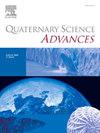Sediment dynamics, neotectonic activity and palaeoenvironments recorded in the Quaternary infill of the central Upper Rhine Graben
IF 2.2
Q2 GEOGRAPHY, PHYSICAL
引用次数: 0
Abstract
The Upper Rhine Graben is a large-scale tectonic basin in central Europe that has accumulated a kilometre-thick sedimentary succession including, in some places, several hundred metres of mostly continuous Quaternary strata. Especially in the central graben part, these strata have hardly been scientifically explored. We introduce a new, 45-m-long drill core record from the vicinity of Offenburg. At its base, it comprises glaciofluvial gravels derived from the Alpine headwaters, which are superseded by aeolian deposits intercalated with locally derived gravels distinct by a different gravel spectrum. Post-infrared infrared-stimulated luminescence dating shows that the entire sequence reaches back beyond 300 ka, and that the glaciofluvial-aeolian transition occurred during the penultimate glaciation at ∼160 ka. By comparison with neighbouring boreholes, we infer repeated normal faulting south of the drill site since roughly the same time, with the resulting topography filled in by locally sourced gravel interbeds. Finally, two layers of fines indicating stagnant palustrine conditions contain interstadial pollen assemblages of the penultimate and last glaciation, and shells of gastropods typical of Pleistocene loess deposits and a glacial palaeoclimate are encountered in the aeolian succession. Thus, this study offers insights into Middle to Late Pleistocene sediment dynamics, neotectonic activity and palaeoenvironments, and highlights the wealth of stratigraphic information that the Upper Rhine Graben preserves.
上莱茵地堑中部第四纪充填记录的沉积动力学、新构造活动与古环境
上莱茵地堑是中欧的一个大型构造盆地,积累了一公里厚的沉积序列,在某些地方,包括数百米的大部分连续的第四纪地层。特别是在中央地堑部分,这些地层几乎没有科学的勘探。我们介绍了一个新的45米长的钻孔岩芯记录,来自Offenburg附近。在它的底部,它包括来自阿尔卑斯源头的冰川河流砾石,这些砾石被风成沉积物所取代,风成沉积物中穿插着当地产生的砾石,其砾石谱不同。后红外激发发光测年表明,整个序列可以追溯到300 ka以后,冰川-河流-风成转变发生在第二次冰期(~ 160 ka)。通过与邻近钻孔的比较,我们推断钻孔地点南部自大约同一时间以来反复出现正断层,由此产生的地形被当地来源的砾石互层填充。最后,两层细粉表明沉积条件停滞,其中包含了倒数第二和末次冰期的期间花粉组合,风成演替中还发现了具有更新世黄土沉积和冰川古气候特征的腹足类壳。因此,本研究提供了对中晚更新世沉积动力学、新构造活动和古环境的深入了解,并突出了上莱茵地堑保存的丰富地层信息。
本文章由计算机程序翻译,如有差异,请以英文原文为准。
求助全文
约1分钟内获得全文
求助全文
来源期刊

Quaternary Science Advances
Earth and Planetary Sciences-Earth-Surface Processes
CiteScore
4.00
自引率
13.30%
发文量
16
审稿时长
61 days
 求助内容:
求助内容: 应助结果提醒方式:
应助结果提醒方式:


